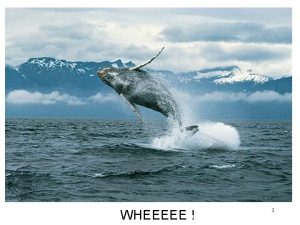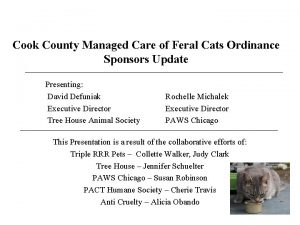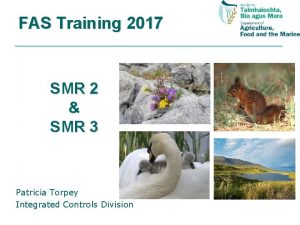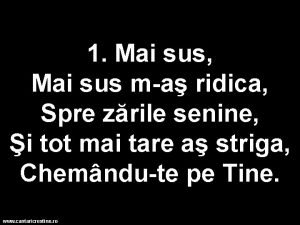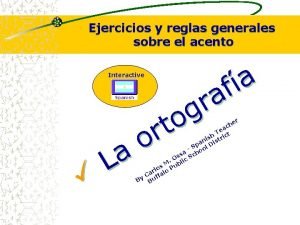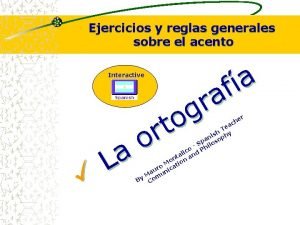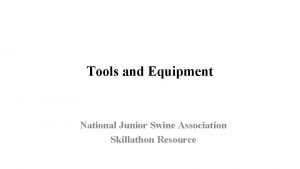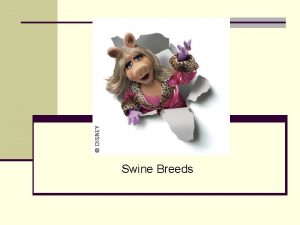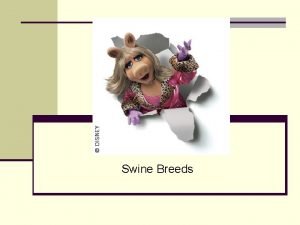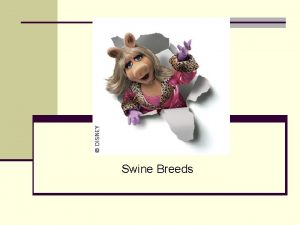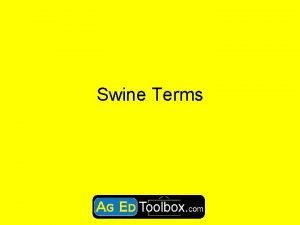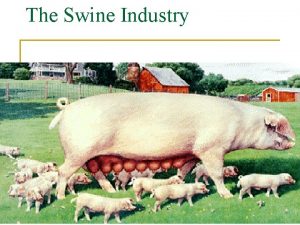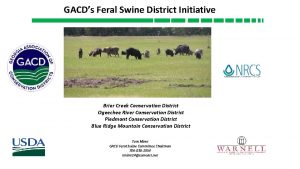Feral swine Sus scrofa Order Artiodactyla family Suidae










- Slides: 10

Feral swine: Sus scrofa ▪ Order Artiodactyla, family Suidae ▪ Any free-roaming swine ▪ Feral descendants of domesticated pig, which descend from wild boar ▪ Wild boar native to Eurasia, North Africa ▪ Prefer habitats with water and dense vegetative cover ▪ Highly adaptable, omnivorous, prolific breeders Photo courtesy of Craig Hicks, USDA Wildlife Services, Bugwood. org

Feral swine: History and Distribution ▪ First brought to NA in 1500 s by explorers, more introductions since then ▪ Intentional translocations, escapes from captivity ▪ Currently found in majority of states ▪ Not established in WA, but seen sometimes Movement of feral swine populations, 1982 -2014. Image courtesy of USDA APHIS

Feral swine: Biology ▪ Can reproduce at young age; 1 -2 litters a year of 4 -8 babies ▪ Related females and young live in ‘sounders’ ▪ Adult males typically solitary ▪ Eats fruit, roots, mushrooms, herbs, smaller animals (vertebrates and invertebrates) ▪ Preferred habitat: ▪ semi-open forests, litter layer and ground vegetation ▪ or marshes and coastal flats A feral swine with her piglets. Photo courtesy of Vladimir Dinets, University of Miami, Bugwood. org

Feral swine: Identification ▪ Wide variety in color and size due to domestication ▪ Coarse bristly hair in black, grey, brown, blonde or red ▪ Males typically larger than females; may have tusks Group of feral swine showing variety of colors possible. Photo courtesy of Billy Higginbotham, Texas Agri. Life Extension Service, Bugwood. org

Feral swine: Identification ▪ Tracks identifiable by rounded shape, possibly visible dewclaws ▪ Scat varies widely in appearance by foods eaten Photos courtesy of Laurence Schafer, USDA Wildlife Services

Feral swine: Identification ▪ Evidence of rooting behavior—‘rototilled’ soil Photos courtesy of Laurence Schafer, USDA Wildlife Services

Feral swine: Impacts ▪ Destroy or consume crops and fields ▪ Prey on livestock ▪ Damage fences, irrigation water systems ▪ Diseases like pseudorabies, brucellosis, tuberculosis, etc. transmittable to people/livestock ▪ Destroy landscaping, parks, cemeteries, sacred & archaeological sites Corn field destroyed by feral swine. Photo courtesy of Craig Hicks, USDA Wildlife Services, Bugwood. org

Feral swine: Impacts ▪ Compete with wildlife ▪ Destroy nests, eat eggs & young reptiles & birds ▪ Transmit diseases to wildlife ▪ Contaminate water sources: ▪ Increased nutrients > toxic algae blooms ▪ Pathogens & parasites like E. coli & giardia ▪ Wallows create mosquito breeding habitat ▪ Disturb vegetation and soil – increase turbidity & invasive plants Photo courtesy of Dan Clark, USDI National Park Service, Bugwood. org

Feral swine: Regulations ▪ Federal ▪ Interstate movement of domestic or feral swine is prohibited without the proper permits (9 CFR 78. 30) ▪ State WACs ▪ Sus genus, free-roaming, not ▪ ▪ domesticated; domestic escapes, releases, or born feral; wild boar/hybrids (16 -54 -010) Prohibited from entering WA (16 -54 -065) Prohibited in WA (16 -54 -111) If found, will be eradicated and disposed of in a humane manner (16 -80 -060) Are deleterious exotic wildlife (232 -12 -017) Feral swine trap being baited. Photo courtesy of Rebekah D. Wallace, University of Georgia, Bugwood. org

Feral swine: Management ▪ Control methods ▪ Trail cameras, bait piles, aerial surveys, detection dogs, e. DNA tests ▪ Trapping, ‘Judas pig, ’ aerial or ground shooting ▪ Outreach efforts ▪ Squeal on Pigs campaign ▪ Federal response: ▪ APHIS, $20 mil/yr on collaborative National Feral Swine Program ▪ Suppression in states with large populations – elimination in states with low populations

